Taxation Law Assignment - Course Name, Term 1, 2020
VerifiedAdded on 2022/09/12
|19
|3873
|22
Homework Assignment
AI Summary
This taxation law assignment comprises two parts: Part A involves a case study analyzing Rachel's residency status under the ITAA 1936, evaluating the application of the resides, domicile, and 183-day tests to determine her Australian residency for the 2019 income year. Part B presents a memo addressing objections to a notice of amended assessment for Julie Banks, covering assessable income, including the doctrine of constructive receipt, and allowable deductions related to Facebook sales, clothing expenses, and home-office expenses under ITAA 1997. The assignment provides detailed legal analysis and application of relevant tax rulings and court decisions to support the conclusions.
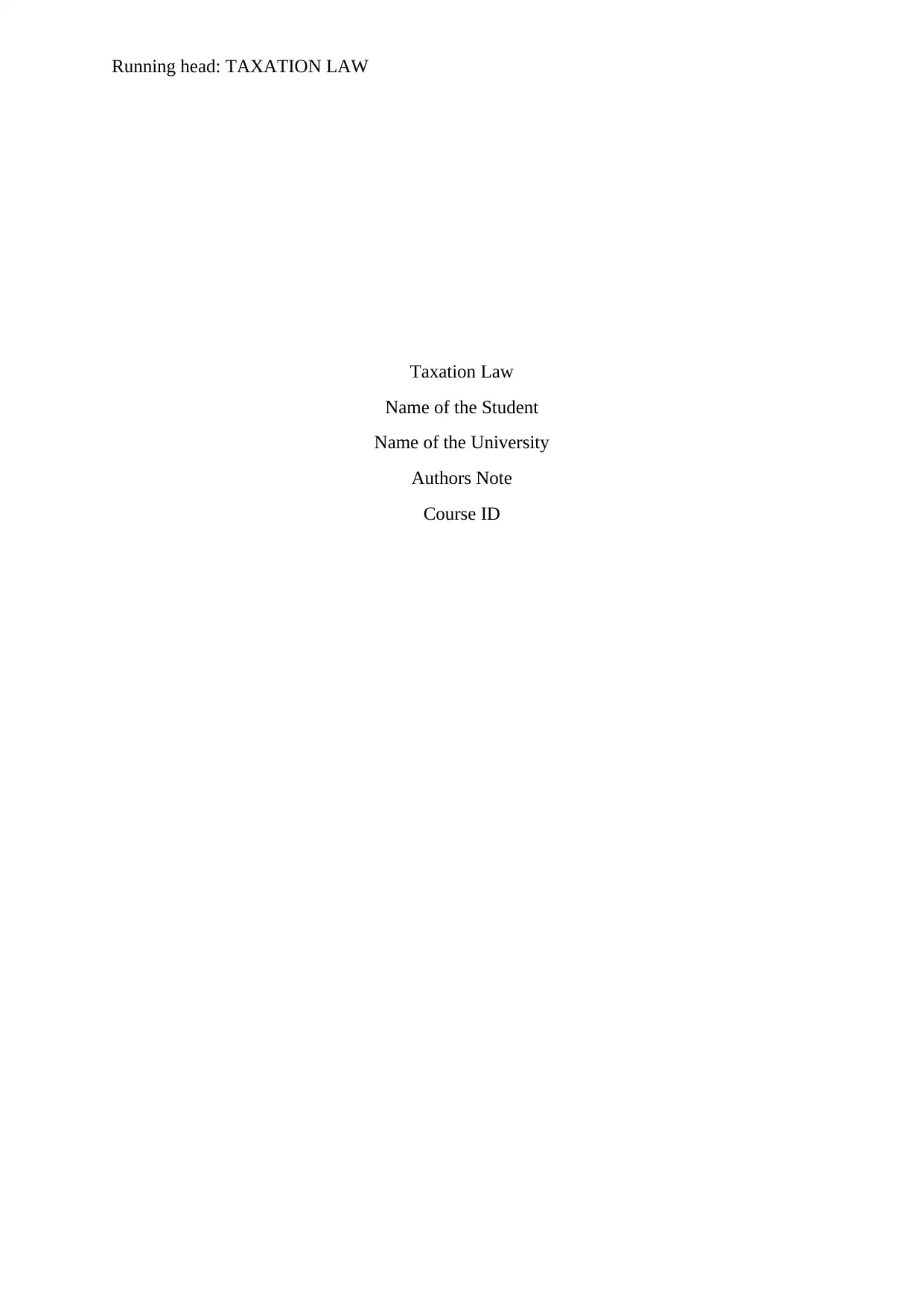
Running head: TAXATION LAW
Taxation Law
Name of the Student
Name of the University
Authors Note
Course ID
Taxation Law
Name of the Student
Name of the University
Authors Note
Course ID
Paraphrase This Document
Need a fresh take? Get an instant paraphrase of this document with our AI Paraphraser
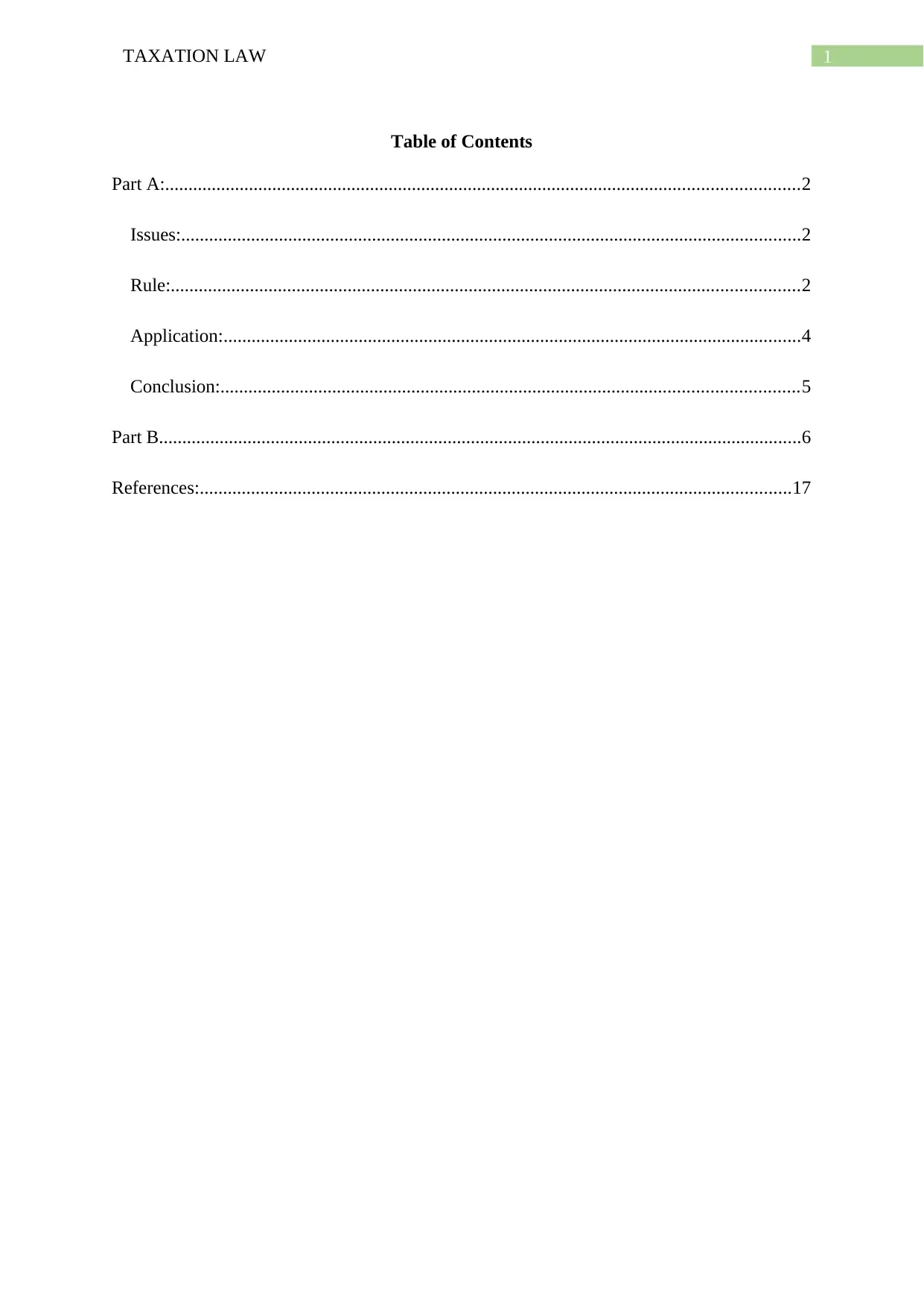
1TAXATION LAW
Table of Contents
Part A:........................................................................................................................................2
Issues:.....................................................................................................................................2
Rule:.......................................................................................................................................2
Application:............................................................................................................................4
Conclusion:............................................................................................................................5
Part B..........................................................................................................................................6
References:...............................................................................................................................17
Table of Contents
Part A:........................................................................................................................................2
Issues:.....................................................................................................................................2
Rule:.......................................................................................................................................2
Application:............................................................................................................................4
Conclusion:............................................................................................................................5
Part B..........................................................................................................................................6
References:...............................................................................................................................17
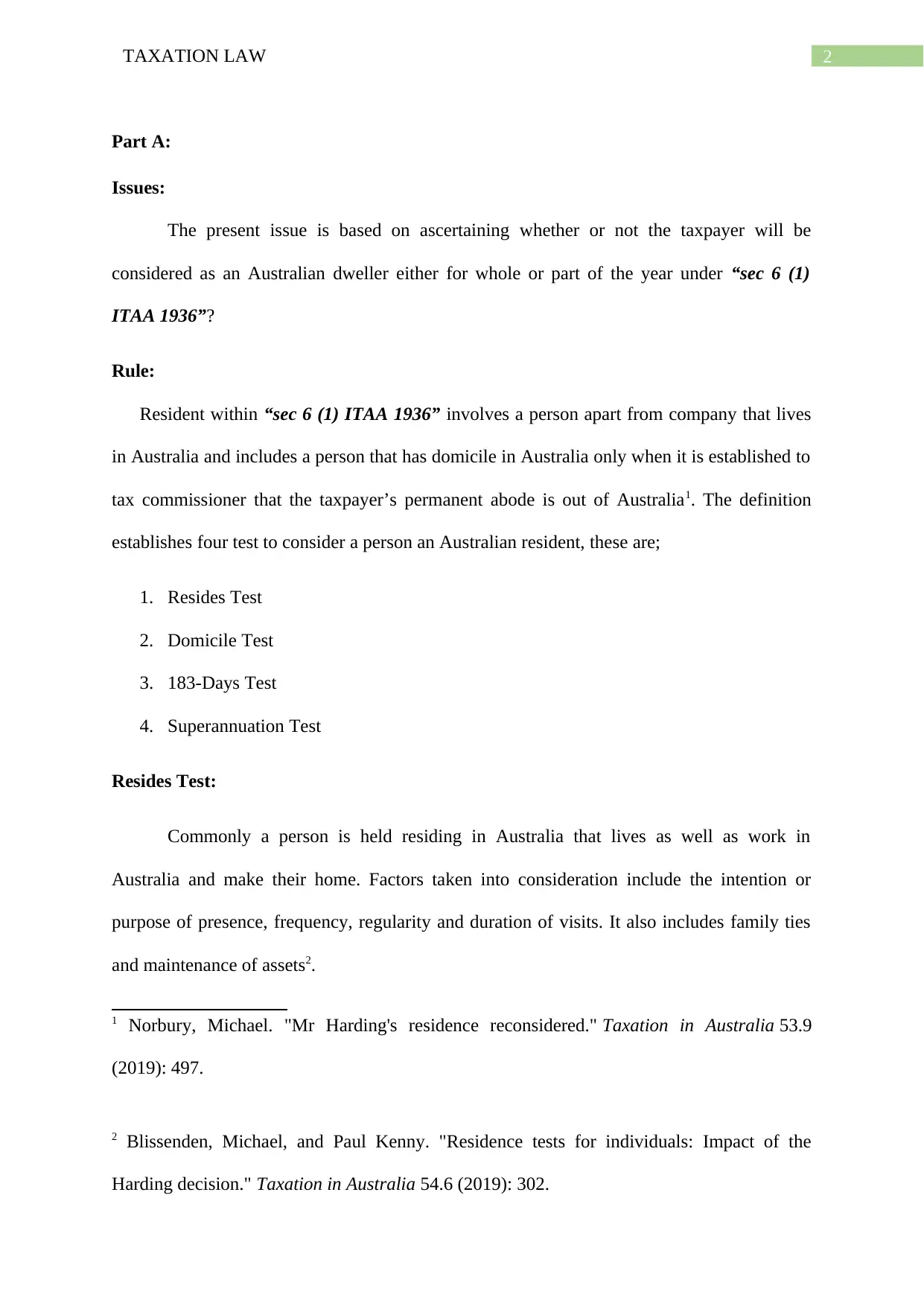
2TAXATION LAW
Part A:
Issues:
The present issue is based on ascertaining whether or not the taxpayer will be
considered as an Australian dweller either for whole or part of the year under “sec 6 (1)
ITAA 1936”?
Rule:
Resident within “sec 6 (1) ITAA 1936” involves a person apart from company that lives
in Australia and includes a person that has domicile in Australia only when it is established to
tax commissioner that the taxpayer’s permanent abode is out of Australia1. The definition
establishes four test to consider a person an Australian resident, these are;
1. Resides Test
2. Domicile Test
3. 183-Days Test
4. Superannuation Test
Resides Test:
Commonly a person is held residing in Australia that lives as well as work in
Australia and make their home. Factors taken into consideration include the intention or
purpose of presence, frequency, regularity and duration of visits. It also includes family ties
and maintenance of assets2.
1 Norbury, Michael. "Mr Harding's residence reconsidered." Taxation in Australia 53.9
(2019): 497.
2 Blissenden, Michael, and Paul Kenny. "Residence tests for individuals: Impact of the
Harding decision." Taxation in Australia 54.6 (2019): 302.
Part A:
Issues:
The present issue is based on ascertaining whether or not the taxpayer will be
considered as an Australian dweller either for whole or part of the year under “sec 6 (1)
ITAA 1936”?
Rule:
Resident within “sec 6 (1) ITAA 1936” involves a person apart from company that lives
in Australia and includes a person that has domicile in Australia only when it is established to
tax commissioner that the taxpayer’s permanent abode is out of Australia1. The definition
establishes four test to consider a person an Australian resident, these are;
1. Resides Test
2. Domicile Test
3. 183-Days Test
4. Superannuation Test
Resides Test:
Commonly a person is held residing in Australia that lives as well as work in
Australia and make their home. Factors taken into consideration include the intention or
purpose of presence, frequency, regularity and duration of visits. It also includes family ties
and maintenance of assets2.
1 Norbury, Michael. "Mr Harding's residence reconsidered." Taxation in Australia 53.9
(2019): 497.
2 Blissenden, Michael, and Paul Kenny. "Residence tests for individuals: Impact of the
Harding decision." Taxation in Australia 54.6 (2019): 302.
⊘ This is a preview!⊘
Do you want full access?
Subscribe today to unlock all pages.

Trusted by 1+ million students worldwide
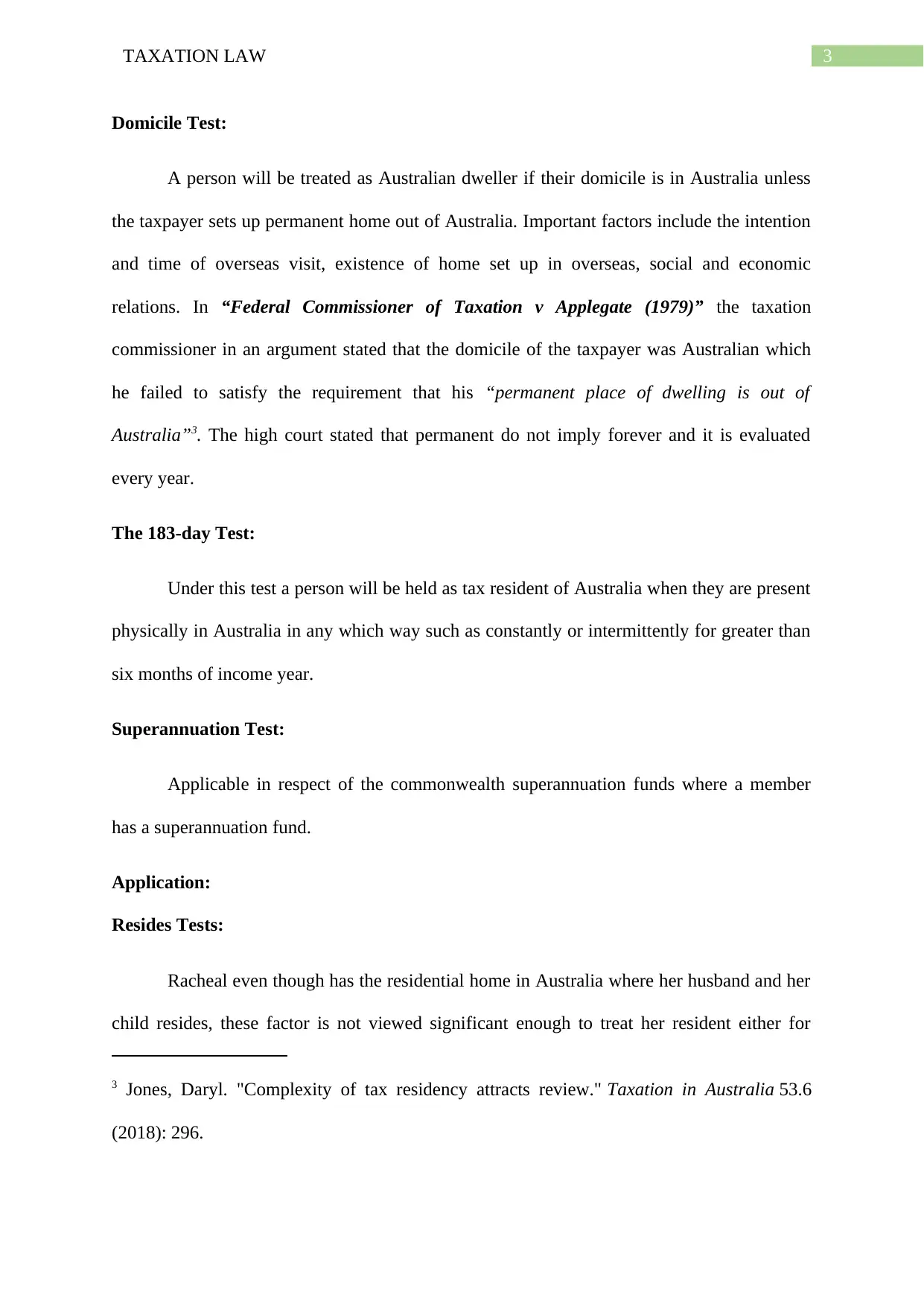
3TAXATION LAW
Domicile Test:
A person will be treated as Australian dweller if their domicile is in Australia unless
the taxpayer sets up permanent home out of Australia. Important factors include the intention
and time of overseas visit, existence of home set up in overseas, social and economic
relations. In “Federal Commissioner of Taxation v Applegate (1979)” the taxation
commissioner in an argument stated that the domicile of the taxpayer was Australian which
he failed to satisfy the requirement that his “permanent place of dwelling is out of
Australia”3. The high court stated that permanent do not imply forever and it is evaluated
every year.
The 183-day Test:
Under this test a person will be held as tax resident of Australia when they are present
physically in Australia in any which way such as constantly or intermittently for greater than
six months of income year.
Superannuation Test:
Applicable in respect of the commonwealth superannuation funds where a member
has a superannuation fund.
Application:
Resides Tests:
Racheal even though has the residential home in Australia where her husband and her
child resides, these factor is not viewed significant enough to treat her resident either for
3 Jones, Daryl. "Complexity of tax residency attracts review." Taxation in Australia 53.6
(2018): 296.
Domicile Test:
A person will be treated as Australian dweller if their domicile is in Australia unless
the taxpayer sets up permanent home out of Australia. Important factors include the intention
and time of overseas visit, existence of home set up in overseas, social and economic
relations. In “Federal Commissioner of Taxation v Applegate (1979)” the taxation
commissioner in an argument stated that the domicile of the taxpayer was Australian which
he failed to satisfy the requirement that his “permanent place of dwelling is out of
Australia”3. The high court stated that permanent do not imply forever and it is evaluated
every year.
The 183-day Test:
Under this test a person will be held as tax resident of Australia when they are present
physically in Australia in any which way such as constantly or intermittently for greater than
six months of income year.
Superannuation Test:
Applicable in respect of the commonwealth superannuation funds where a member
has a superannuation fund.
Application:
Resides Tests:
Racheal even though has the residential home in Australia where her husband and her
child resides, these factor is not viewed significant enough to treat her resident either for
3 Jones, Daryl. "Complexity of tax residency attracts review." Taxation in Australia 53.6
(2018): 296.
Paraphrase This Document
Need a fresh take? Get an instant paraphrase of this document with our AI Paraphraser
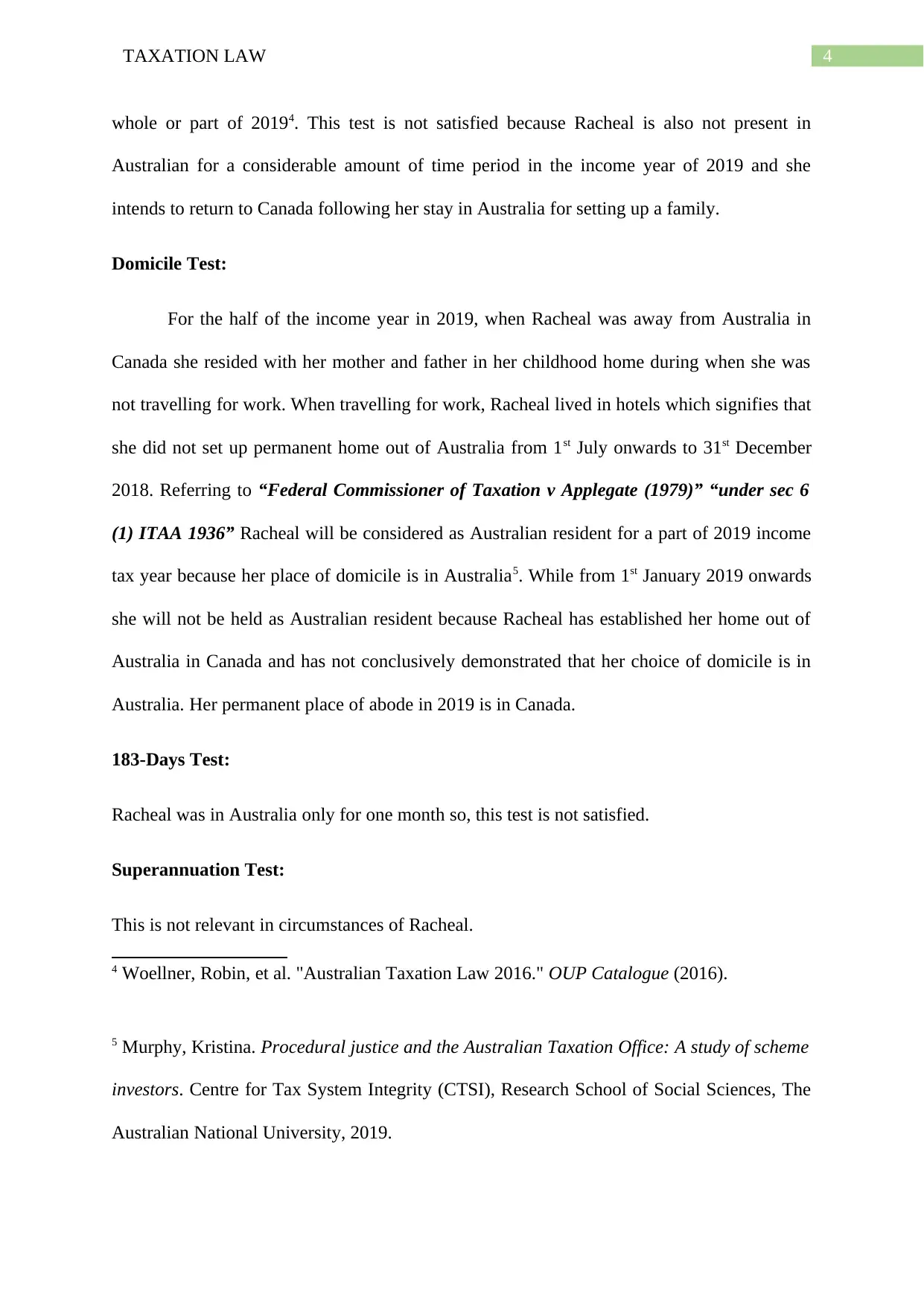
4TAXATION LAW
whole or part of 20194. This test is not satisfied because Racheal is also not present in
Australian for a considerable amount of time period in the income year of 2019 and she
intends to return to Canada following her stay in Australia for setting up a family.
Domicile Test:
For the half of the income year in 2019, when Racheal was away from Australia in
Canada she resided with her mother and father in her childhood home during when she was
not travelling for work. When travelling for work, Racheal lived in hotels which signifies that
she did not set up permanent home out of Australia from 1st July onwards to 31st December
2018. Referring to “Federal Commissioner of Taxation v Applegate (1979)” “under sec 6
(1) ITAA 1936” Racheal will be considered as Australian resident for a part of 2019 income
tax year because her place of domicile is in Australia5. While from 1st January 2019 onwards
she will not be held as Australian resident because Racheal has established her home out of
Australia in Canada and has not conclusively demonstrated that her choice of domicile is in
Australia. Her permanent place of abode in 2019 is in Canada.
183-Days Test:
Racheal was in Australia only for one month so, this test is not satisfied.
Superannuation Test:
This is not relevant in circumstances of Racheal.
4 Woellner, Robin, et al. "Australian Taxation Law 2016." OUP Catalogue (2016).
5 Murphy, Kristina. Procedural justice and the Australian Taxation Office: A study of scheme
investors. Centre for Tax System Integrity (CTSI), Research School of Social Sciences, The
Australian National University, 2019.
whole or part of 20194. This test is not satisfied because Racheal is also not present in
Australian for a considerable amount of time period in the income year of 2019 and she
intends to return to Canada following her stay in Australia for setting up a family.
Domicile Test:
For the half of the income year in 2019, when Racheal was away from Australia in
Canada she resided with her mother and father in her childhood home during when she was
not travelling for work. When travelling for work, Racheal lived in hotels which signifies that
she did not set up permanent home out of Australia from 1st July onwards to 31st December
2018. Referring to “Federal Commissioner of Taxation v Applegate (1979)” “under sec 6
(1) ITAA 1936” Racheal will be considered as Australian resident for a part of 2019 income
tax year because her place of domicile is in Australia5. While from 1st January 2019 onwards
she will not be held as Australian resident because Racheal has established her home out of
Australia in Canada and has not conclusively demonstrated that her choice of domicile is in
Australia. Her permanent place of abode in 2019 is in Canada.
183-Days Test:
Racheal was in Australia only for one month so, this test is not satisfied.
Superannuation Test:
This is not relevant in circumstances of Racheal.
4 Woellner, Robin, et al. "Australian Taxation Law 2016." OUP Catalogue (2016).
5 Murphy, Kristina. Procedural justice and the Australian Taxation Office: A study of scheme
investors. Centre for Tax System Integrity (CTSI), Research School of Social Sciences, The
Australian National University, 2019.
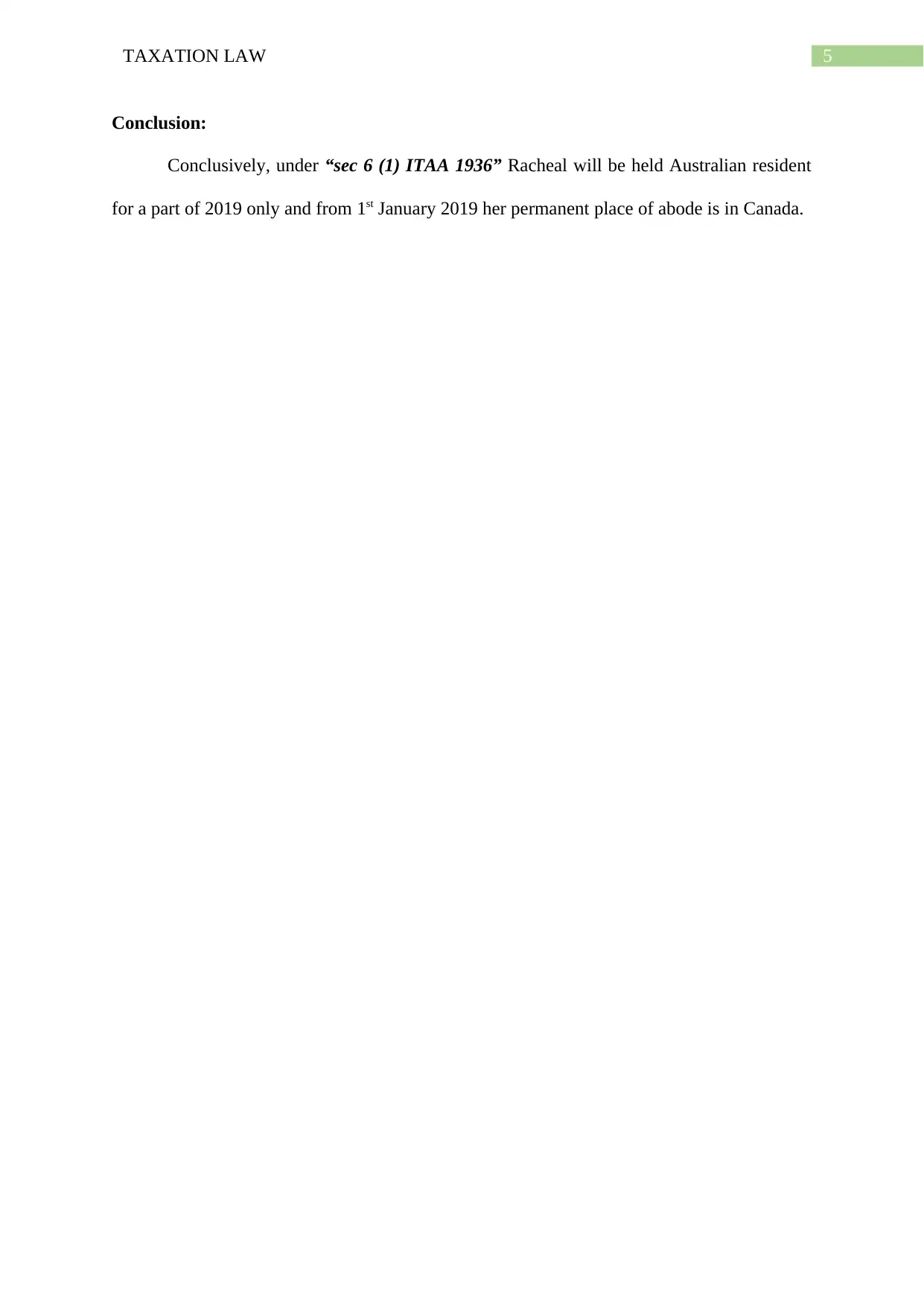
5TAXATION LAW
Conclusion:
Conclusively, under “sec 6 (1) ITAA 1936” Racheal will be held Australian resident
for a part of 2019 only and from 1st January 2019 her permanent place of abode is in Canada.
Conclusion:
Conclusively, under “sec 6 (1) ITAA 1936” Racheal will be held Australian resident
for a part of 2019 only and from 1st January 2019 her permanent place of abode is in Canada.
⊘ This is a preview!⊘
Do you want full access?
Subscribe today to unlock all pages.

Trusted by 1+ million students worldwide
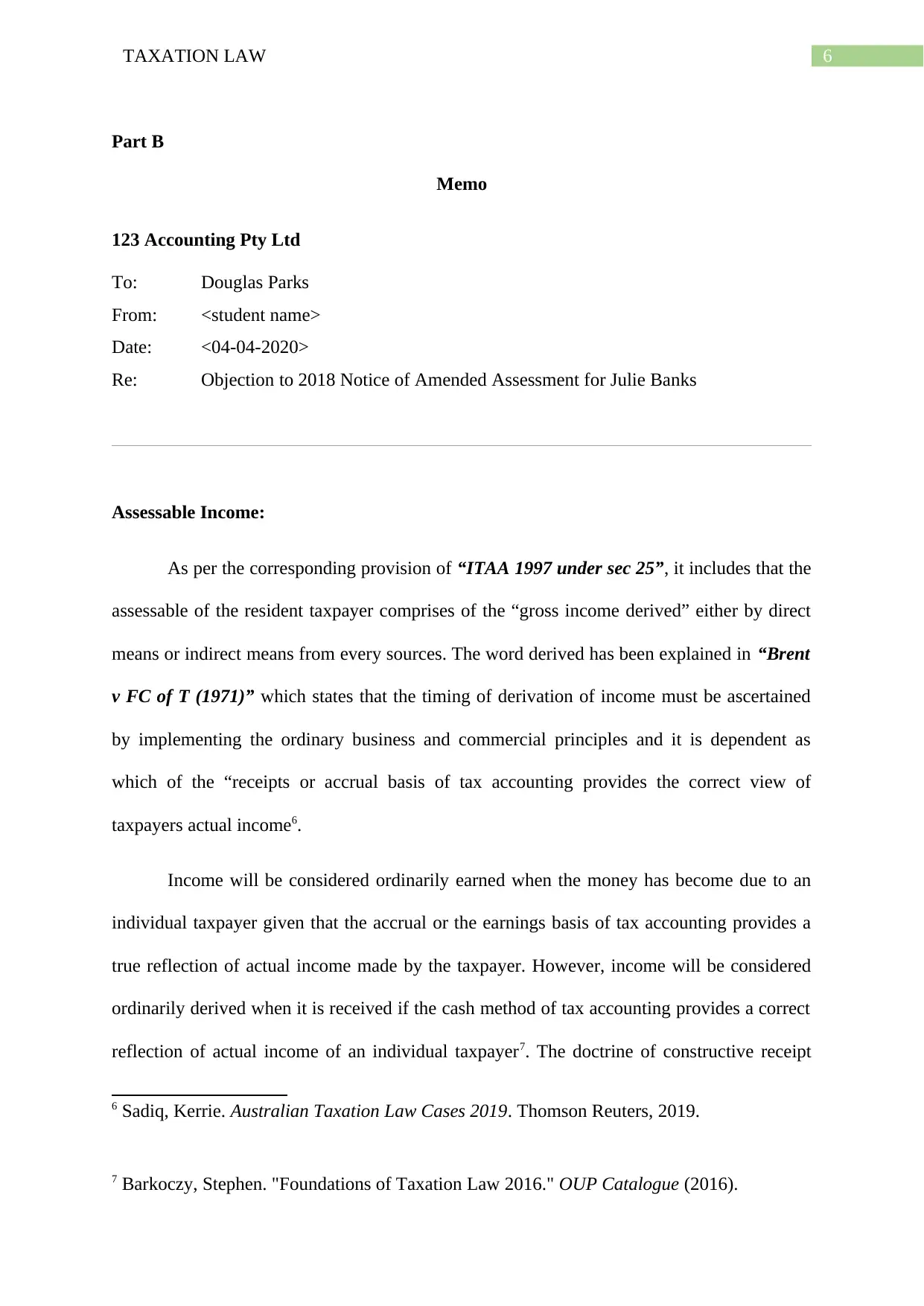
6TAXATION LAW
Part B
Memo
123 Accounting Pty Ltd
To: Douglas Parks
From: <student name>
Date: <04-04-2020>
Re: Objection to 2018 Notice of Amended Assessment for Julie Banks
Assessable Income:
As per the corresponding provision of “ITAA 1997 under sec 25”, it includes that the
assessable of the resident taxpayer comprises of the “gross income derived” either by direct
means or indirect means from every sources. The word derived has been explained in “Brent
v FC of T (1971)” which states that the timing of derivation of income must be ascertained
by implementing the ordinary business and commercial principles and it is dependent as
which of the “receipts or accrual basis of tax accounting provides the correct view of
taxpayers actual income6.
Income will be considered ordinarily earned when the money has become due to an
individual taxpayer given that the accrual or the earnings basis of tax accounting provides a
true reflection of actual income made by the taxpayer. However, income will be considered
ordinarily derived when it is received if the cash method of tax accounting provides a correct
reflection of actual income of an individual taxpayer7. The doctrine of constructive receipt
6 Sadiq, Kerrie. Australian Taxation Law Cases 2019. Thomson Reuters, 2019.
7 Barkoczy, Stephen. "Foundations of Taxation Law 2016." OUP Catalogue (2016).
Part B
Memo
123 Accounting Pty Ltd
To: Douglas Parks
From: <student name>
Date: <04-04-2020>
Re: Objection to 2018 Notice of Amended Assessment for Julie Banks
Assessable Income:
As per the corresponding provision of “ITAA 1997 under sec 25”, it includes that the
assessable of the resident taxpayer comprises of the “gross income derived” either by direct
means or indirect means from every sources. The word derived has been explained in “Brent
v FC of T (1971)” which states that the timing of derivation of income must be ascertained
by implementing the ordinary business and commercial principles and it is dependent as
which of the “receipts or accrual basis of tax accounting provides the correct view of
taxpayers actual income6.
Income will be considered ordinarily earned when the money has become due to an
individual taxpayer given that the accrual or the earnings basis of tax accounting provides a
true reflection of actual income made by the taxpayer. However, income will be considered
ordinarily derived when it is received if the cash method of tax accounting provides a correct
reflection of actual income of an individual taxpayer7. The doctrine of constructive receipt
6 Sadiq, Kerrie. Australian Taxation Law Cases 2019. Thomson Reuters, 2019.
7 Barkoczy, Stephen. "Foundations of Taxation Law 2016." OUP Catalogue (2016).
Paraphrase This Document
Need a fresh take? Get an instant paraphrase of this document with our AI Paraphraser
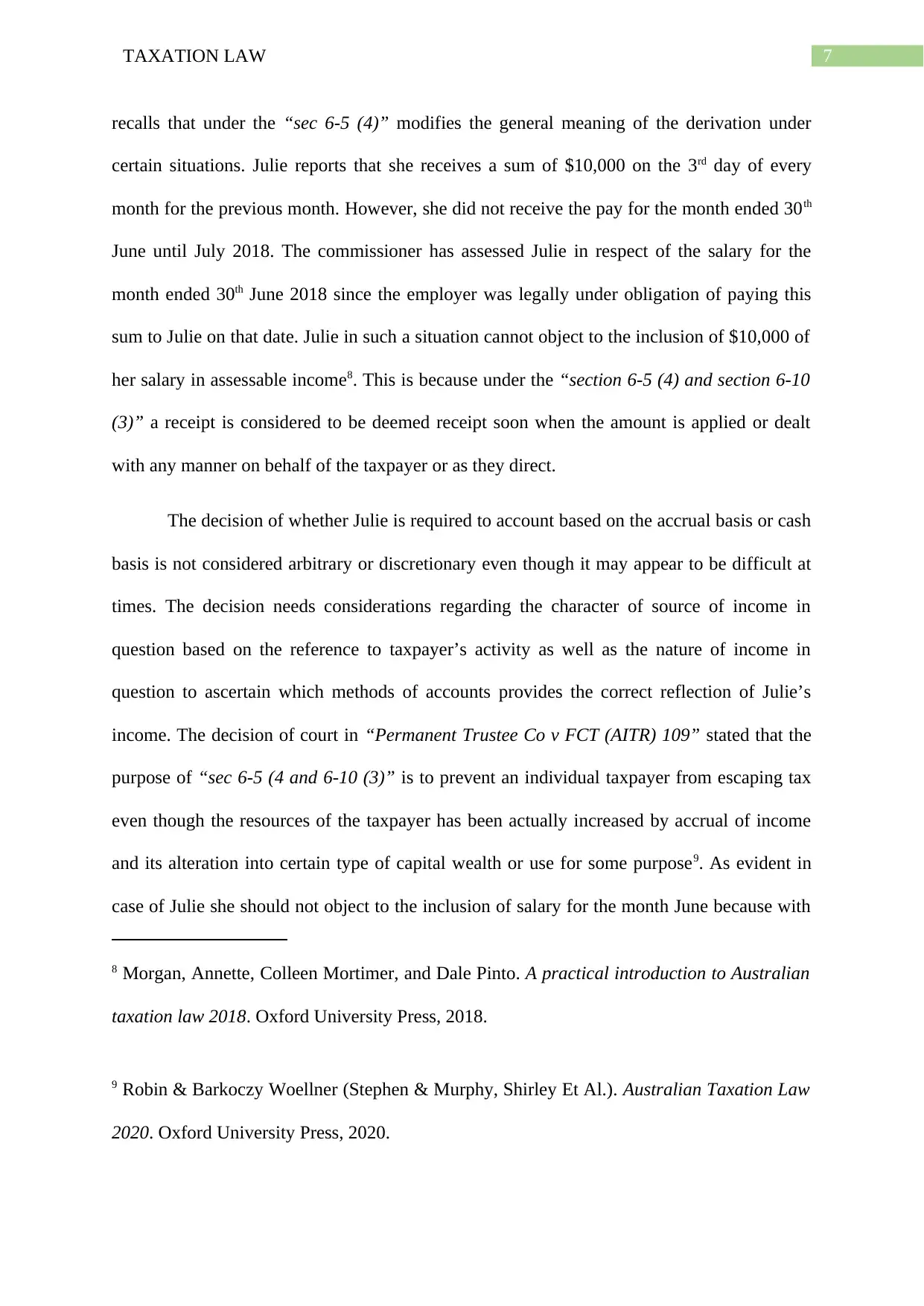
7TAXATION LAW
recalls that under the “sec 6-5 (4)” modifies the general meaning of the derivation under
certain situations. Julie reports that she receives a sum of $10,000 on the 3rd day of every
month for the previous month. However, she did not receive the pay for the month ended 30th
June until July 2018. The commissioner has assessed Julie in respect of the salary for the
month ended 30th June 2018 since the employer was legally under obligation of paying this
sum to Julie on that date. Julie in such a situation cannot object to the inclusion of $10,000 of
her salary in assessable income8. This is because under the “section 6-5 (4) and section 6-10
(3)” a receipt is considered to be deemed receipt soon when the amount is applied or dealt
with any manner on behalf of the taxpayer or as they direct.
The decision of whether Julie is required to account based on the accrual basis or cash
basis is not considered arbitrary or discretionary even though it may appear to be difficult at
times. The decision needs considerations regarding the character of source of income in
question based on the reference to taxpayer’s activity as well as the nature of income in
question to ascertain which methods of accounts provides the correct reflection of Julie’s
income. The decision of court in “Permanent Trustee Co v FCT (AITR) 109” stated that the
purpose of “sec 6-5 (4 and 6-10 (3)” is to prevent an individual taxpayer from escaping tax
even though the resources of the taxpayer has been actually increased by accrual of income
and its alteration into certain type of capital wealth or use for some purpose9. As evident in
case of Julie she should not object to the inclusion of salary for the month June because with
8 Morgan, Annette, Colleen Mortimer, and Dale Pinto. A practical introduction to Australian
taxation law 2018. Oxford University Press, 2018.
9 Robin & Barkoczy Woellner (Stephen & Murphy, Shirley Et Al.). Australian Taxation Law
2020. Oxford University Press, 2020.
recalls that under the “sec 6-5 (4)” modifies the general meaning of the derivation under
certain situations. Julie reports that she receives a sum of $10,000 on the 3rd day of every
month for the previous month. However, she did not receive the pay for the month ended 30th
June until July 2018. The commissioner has assessed Julie in respect of the salary for the
month ended 30th June 2018 since the employer was legally under obligation of paying this
sum to Julie on that date. Julie in such a situation cannot object to the inclusion of $10,000 of
her salary in assessable income8. This is because under the “section 6-5 (4) and section 6-10
(3)” a receipt is considered to be deemed receipt soon when the amount is applied or dealt
with any manner on behalf of the taxpayer or as they direct.
The decision of whether Julie is required to account based on the accrual basis or cash
basis is not considered arbitrary or discretionary even though it may appear to be difficult at
times. The decision needs considerations regarding the character of source of income in
question based on the reference to taxpayer’s activity as well as the nature of income in
question to ascertain which methods of accounts provides the correct reflection of Julie’s
income. The decision of court in “Permanent Trustee Co v FCT (AITR) 109” stated that the
purpose of “sec 6-5 (4 and 6-10 (3)” is to prevent an individual taxpayer from escaping tax
even though the resources of the taxpayer has been actually increased by accrual of income
and its alteration into certain type of capital wealth or use for some purpose9. As evident in
case of Julie she should not object to the inclusion of salary for the month June because with
8 Morgan, Annette, Colleen Mortimer, and Dale Pinto. A practical introduction to Australian
taxation law 2018. Oxford University Press, 2018.
9 Robin & Barkoczy Woellner (Stephen & Murphy, Shirley Et Al.). Australian Taxation Law
2020. Oxford University Press, 2020.
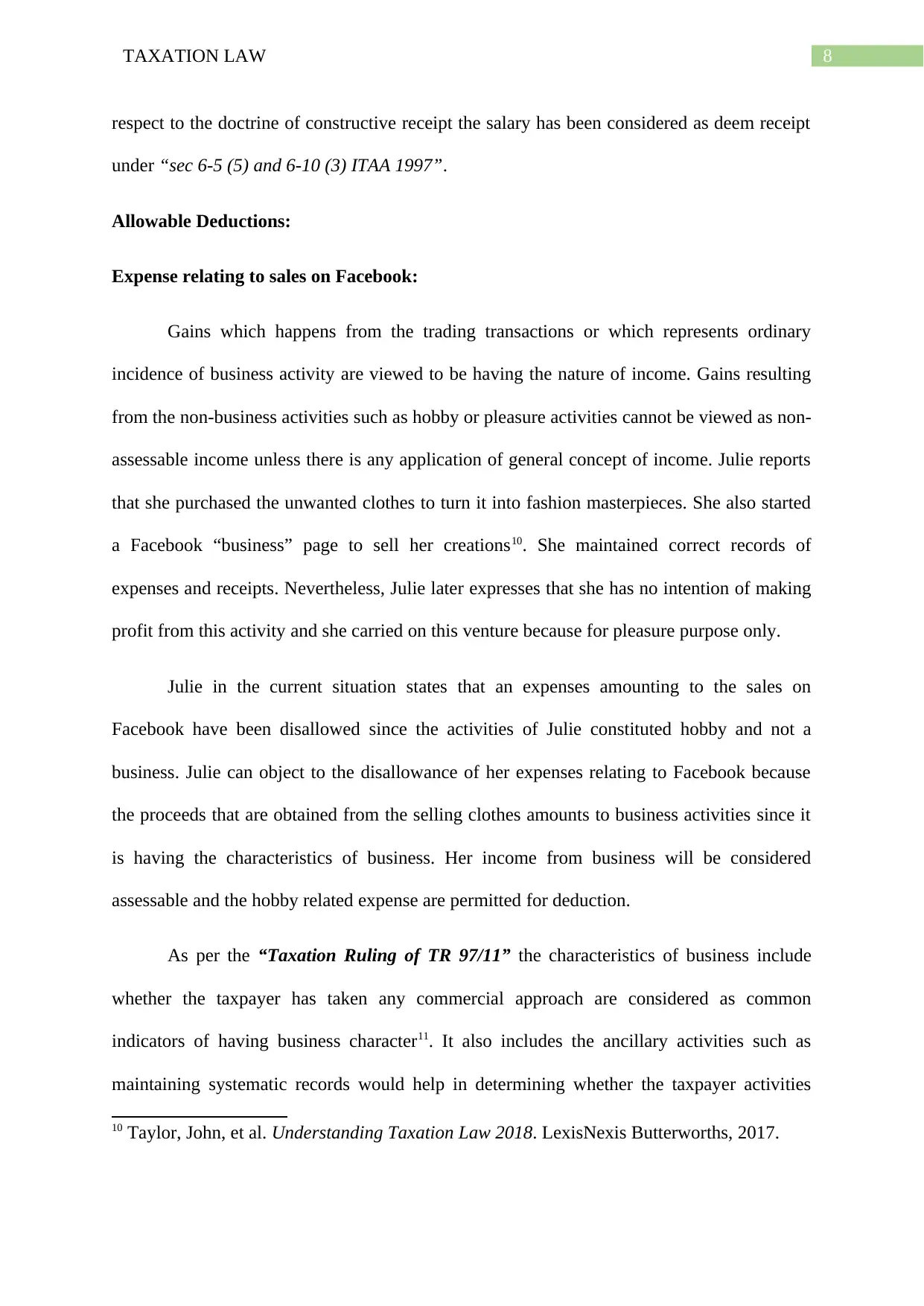
8TAXATION LAW
respect to the doctrine of constructive receipt the salary has been considered as deem receipt
under “sec 6-5 (5) and 6-10 (3) ITAA 1997”.
Allowable Deductions:
Expense relating to sales on Facebook:
Gains which happens from the trading transactions or which represents ordinary
incidence of business activity are viewed to be having the nature of income. Gains resulting
from the non-business activities such as hobby or pleasure activities cannot be viewed as non-
assessable income unless there is any application of general concept of income. Julie reports
that she purchased the unwanted clothes to turn it into fashion masterpieces. She also started
a Facebook “business” page to sell her creations10. She maintained correct records of
expenses and receipts. Nevertheless, Julie later expresses that she has no intention of making
profit from this activity and she carried on this venture because for pleasure purpose only.
Julie in the current situation states that an expenses amounting to the sales on
Facebook have been disallowed since the activities of Julie constituted hobby and not a
business. Julie can object to the disallowance of her expenses relating to Facebook because
the proceeds that are obtained from the selling clothes amounts to business activities since it
is having the characteristics of business. Her income from business will be considered
assessable and the hobby related expense are permitted for deduction.
As per the “Taxation Ruling of TR 97/11” the characteristics of business include
whether the taxpayer has taken any commercial approach are considered as common
indicators of having business character11. It also includes the ancillary activities such as
maintaining systematic records would help in determining whether the taxpayer activities
10 Taylor, John, et al. Understanding Taxation Law 2018. LexisNexis Butterworths, 2017.
respect to the doctrine of constructive receipt the salary has been considered as deem receipt
under “sec 6-5 (5) and 6-10 (3) ITAA 1997”.
Allowable Deductions:
Expense relating to sales on Facebook:
Gains which happens from the trading transactions or which represents ordinary
incidence of business activity are viewed to be having the nature of income. Gains resulting
from the non-business activities such as hobby or pleasure activities cannot be viewed as non-
assessable income unless there is any application of general concept of income. Julie reports
that she purchased the unwanted clothes to turn it into fashion masterpieces. She also started
a Facebook “business” page to sell her creations10. She maintained correct records of
expenses and receipts. Nevertheless, Julie later expresses that she has no intention of making
profit from this activity and she carried on this venture because for pleasure purpose only.
Julie in the current situation states that an expenses amounting to the sales on
Facebook have been disallowed since the activities of Julie constituted hobby and not a
business. Julie can object to the disallowance of her expenses relating to Facebook because
the proceeds that are obtained from the selling clothes amounts to business activities since it
is having the characteristics of business. Her income from business will be considered
assessable and the hobby related expense are permitted for deduction.
As per the “Taxation Ruling of TR 97/11” the characteristics of business include
whether the taxpayer has taken any commercial approach are considered as common
indicators of having business character11. It also includes the ancillary activities such as
maintaining systematic records would help in determining whether the taxpayer activities
10 Taylor, John, et al. Understanding Taxation Law 2018. LexisNexis Butterworths, 2017.
⊘ This is a preview!⊘
Do you want full access?
Subscribe today to unlock all pages.

Trusted by 1+ million students worldwide
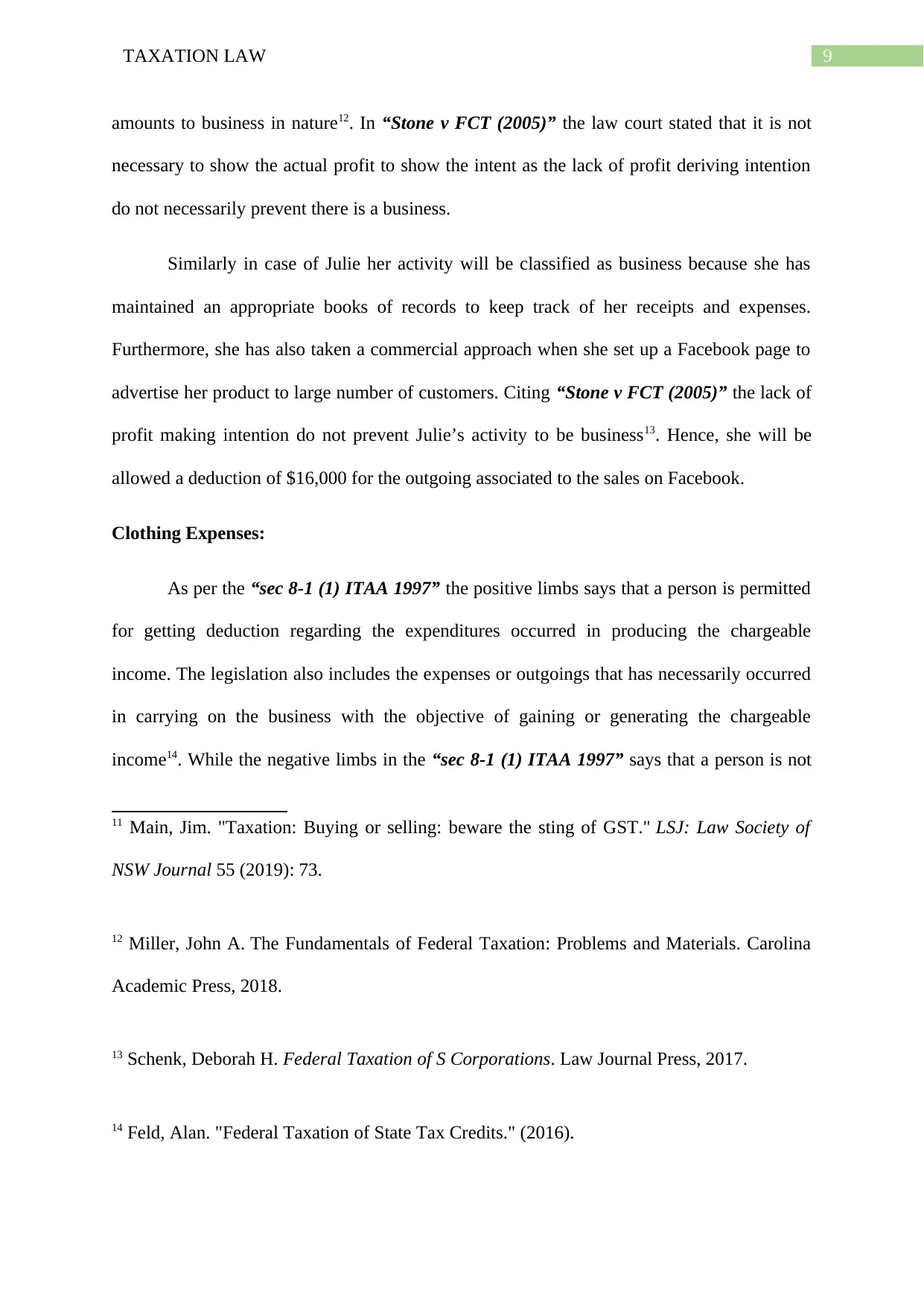
9TAXATION LAW
amounts to business in nature12. In “Stone v FCT (2005)” the law court stated that it is not
necessary to show the actual profit to show the intent as the lack of profit deriving intention
do not necessarily prevent there is a business.
Similarly in case of Julie her activity will be classified as business because she has
maintained an appropriate books of records to keep track of her receipts and expenses.
Furthermore, she has also taken a commercial approach when she set up a Facebook page to
advertise her product to large number of customers. Citing “Stone v FCT (2005)” the lack of
profit making intention do not prevent Julie’s activity to be business13. Hence, she will be
allowed a deduction of $16,000 for the outgoing associated to the sales on Facebook.
Clothing Expenses:
As per the “sec 8-1 (1) ITAA 1997” the positive limbs says that a person is permitted
for getting deduction regarding the expenditures occurred in producing the chargeable
income. The legislation also includes the expenses or outgoings that has necessarily occurred
in carrying on the business with the objective of gaining or generating the chargeable
income14. While the negative limbs in the “sec 8-1 (1) ITAA 1997” says that a person is not
11 Main, Jim. "Taxation: Buying or selling: beware the sting of GST." LSJ: Law Society of
NSW Journal 55 (2019): 73.
12 Miller, John A. The Fundamentals of Federal Taxation: Problems and Materials. Carolina
Academic Press, 2018.
13 Schenk, Deborah H. Federal Taxation of S Corporations. Law Journal Press, 2017.
14 Feld, Alan. "Federal Taxation of State Tax Credits." (2016).
amounts to business in nature12. In “Stone v FCT (2005)” the law court stated that it is not
necessary to show the actual profit to show the intent as the lack of profit deriving intention
do not necessarily prevent there is a business.
Similarly in case of Julie her activity will be classified as business because she has
maintained an appropriate books of records to keep track of her receipts and expenses.
Furthermore, she has also taken a commercial approach when she set up a Facebook page to
advertise her product to large number of customers. Citing “Stone v FCT (2005)” the lack of
profit making intention do not prevent Julie’s activity to be business13. Hence, she will be
allowed a deduction of $16,000 for the outgoing associated to the sales on Facebook.
Clothing Expenses:
As per the “sec 8-1 (1) ITAA 1997” the positive limbs says that a person is permitted
for getting deduction regarding the expenditures occurred in producing the chargeable
income. The legislation also includes the expenses or outgoings that has necessarily occurred
in carrying on the business with the objective of gaining or generating the chargeable
income14. While the negative limbs in the “sec 8-1 (1) ITAA 1997” says that a person is not
11 Main, Jim. "Taxation: Buying or selling: beware the sting of GST." LSJ: Law Society of
NSW Journal 55 (2019): 73.
12 Miller, John A. The Fundamentals of Federal Taxation: Problems and Materials. Carolina
Academic Press, 2018.
13 Schenk, Deborah H. Federal Taxation of S Corporations. Law Journal Press, 2017.
14 Feld, Alan. "Federal Taxation of State Tax Credits." (2016).
Paraphrase This Document
Need a fresh take? Get an instant paraphrase of this document with our AI Paraphraser
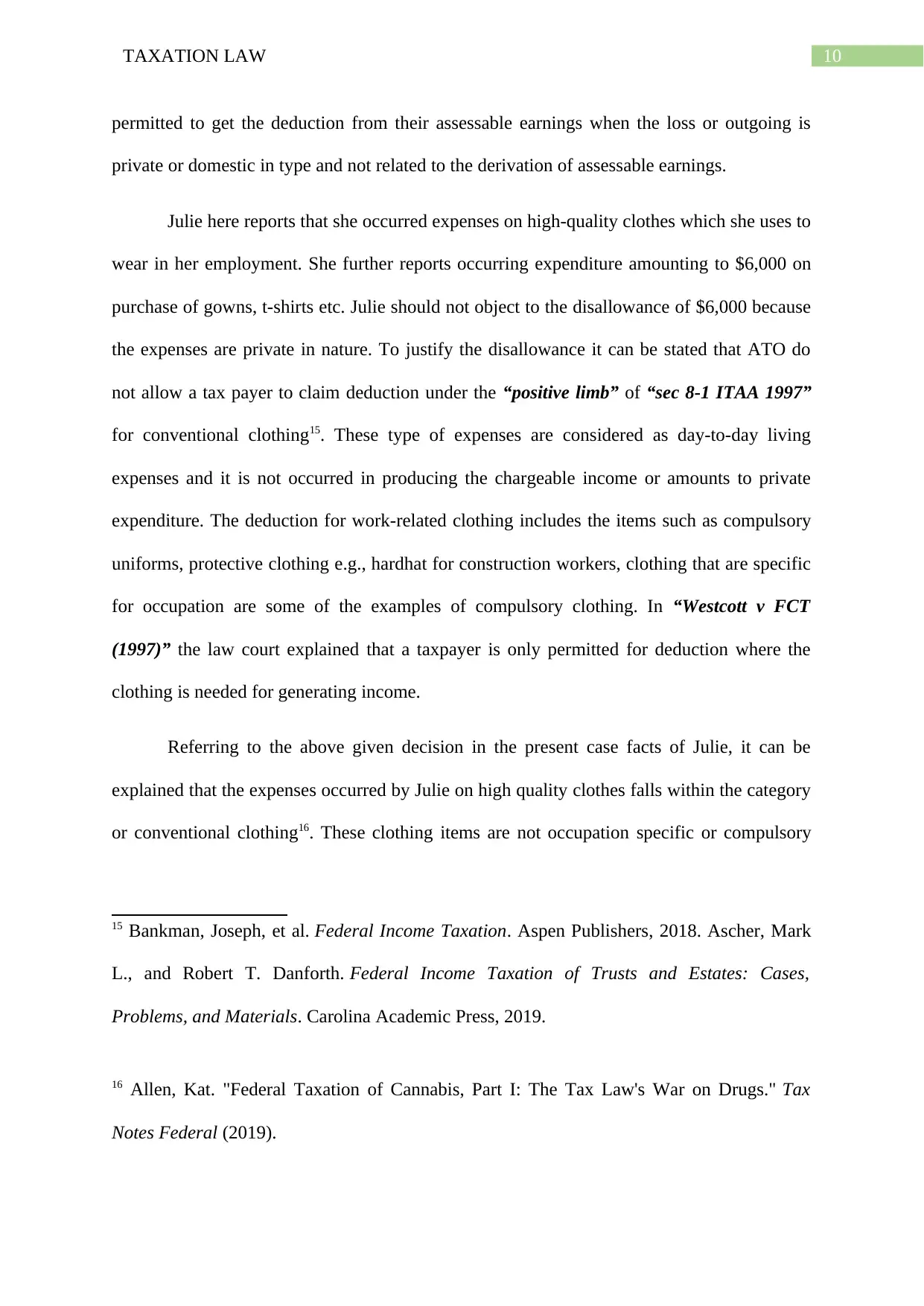
10TAXATION LAW
permitted to get the deduction from their assessable earnings when the loss or outgoing is
private or domestic in type and not related to the derivation of assessable earnings.
Julie here reports that she occurred expenses on high-quality clothes which she uses to
wear in her employment. She further reports occurring expenditure amounting to $6,000 on
purchase of gowns, t-shirts etc. Julie should not object to the disallowance of $6,000 because
the expenses are private in nature. To justify the disallowance it can be stated that ATO do
not allow a tax payer to claim deduction under the “positive limb” of “sec 8-1 ITAA 1997”
for conventional clothing15. These type of expenses are considered as day-to-day living
expenses and it is not occurred in producing the chargeable income or amounts to private
expenditure. The deduction for work-related clothing includes the items such as compulsory
uniforms, protective clothing e.g., hardhat for construction workers, clothing that are specific
for occupation are some of the examples of compulsory clothing. In “Westcott v FCT
(1997)” the law court explained that a taxpayer is only permitted for deduction where the
clothing is needed for generating income.
Referring to the above given decision in the present case facts of Julie, it can be
explained that the expenses occurred by Julie on high quality clothes falls within the category
or conventional clothing16. These clothing items are not occupation specific or compulsory
15 Bankman, Joseph, et al. Federal Income Taxation. Aspen Publishers, 2018. Ascher, Mark
L., and Robert T. Danforth. Federal Income Taxation of Trusts and Estates: Cases,
Problems, and Materials. Carolina Academic Press, 2019.
16 Allen, Kat. "Federal Taxation of Cannabis, Part I: The Tax Law's War on Drugs." Tax
Notes Federal (2019).
permitted to get the deduction from their assessable earnings when the loss or outgoing is
private or domestic in type and not related to the derivation of assessable earnings.
Julie here reports that she occurred expenses on high-quality clothes which she uses to
wear in her employment. She further reports occurring expenditure amounting to $6,000 on
purchase of gowns, t-shirts etc. Julie should not object to the disallowance of $6,000 because
the expenses are private in nature. To justify the disallowance it can be stated that ATO do
not allow a tax payer to claim deduction under the “positive limb” of “sec 8-1 ITAA 1997”
for conventional clothing15. These type of expenses are considered as day-to-day living
expenses and it is not occurred in producing the chargeable income or amounts to private
expenditure. The deduction for work-related clothing includes the items such as compulsory
uniforms, protective clothing e.g., hardhat for construction workers, clothing that are specific
for occupation are some of the examples of compulsory clothing. In “Westcott v FCT
(1997)” the law court explained that a taxpayer is only permitted for deduction where the
clothing is needed for generating income.
Referring to the above given decision in the present case facts of Julie, it can be
explained that the expenses occurred by Julie on high quality clothes falls within the category
or conventional clothing16. These clothing items are not occupation specific or compulsory
15 Bankman, Joseph, et al. Federal Income Taxation. Aspen Publishers, 2018. Ascher, Mark
L., and Robert T. Danforth. Federal Income Taxation of Trusts and Estates: Cases,
Problems, and Materials. Carolina Academic Press, 2019.
16 Allen, Kat. "Federal Taxation of Cannabis, Part I: The Tax Law's War on Drugs." Tax
Notes Federal (2019).
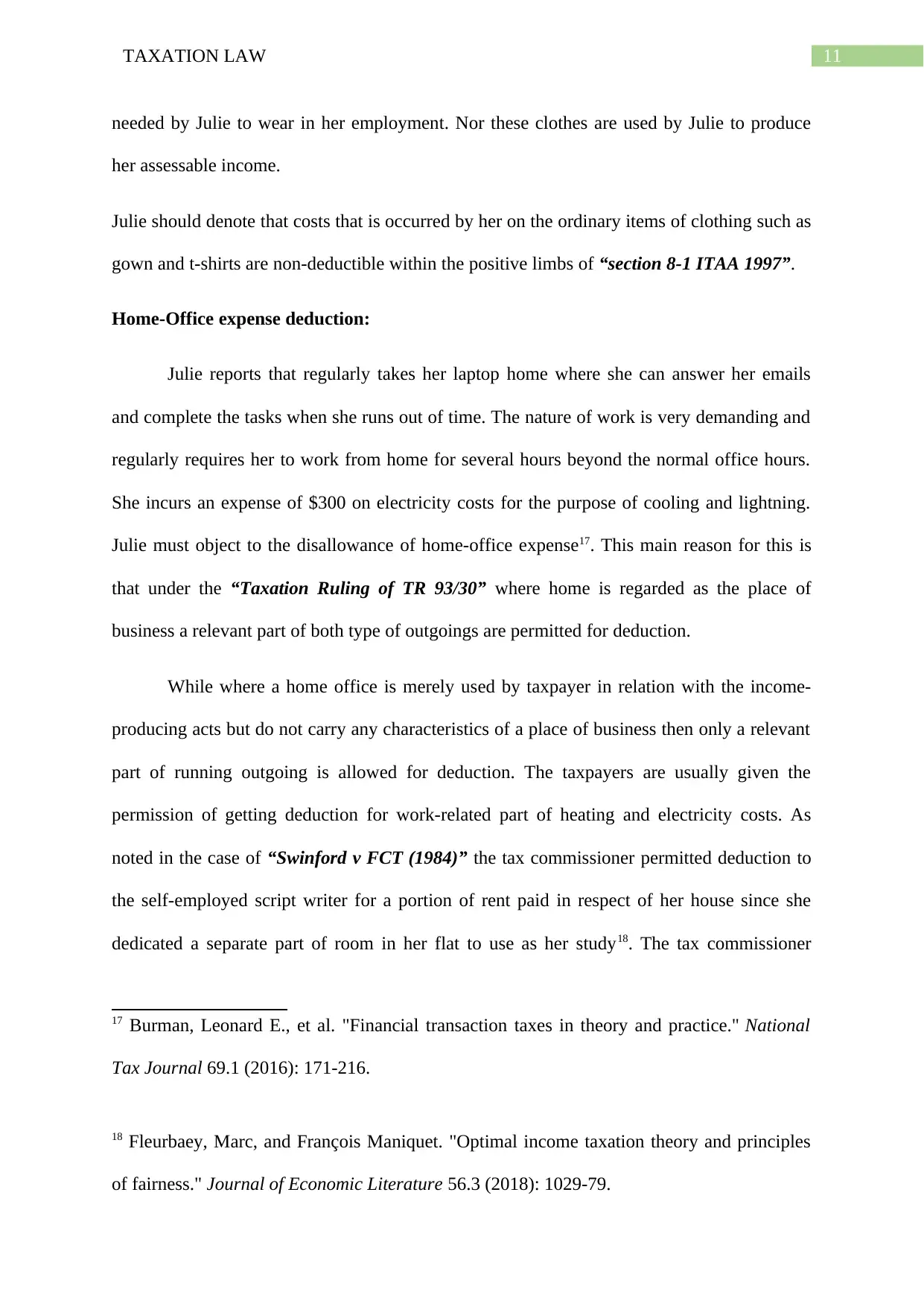
11TAXATION LAW
needed by Julie to wear in her employment. Nor these clothes are used by Julie to produce
her assessable income.
Julie should denote that costs that is occurred by her on the ordinary items of clothing such as
gown and t-shirts are non-deductible within the positive limbs of “section 8-1 ITAA 1997”.
Home-Office expense deduction:
Julie reports that regularly takes her laptop home where she can answer her emails
and complete the tasks when she runs out of time. The nature of work is very demanding and
regularly requires her to work from home for several hours beyond the normal office hours.
She incurs an expense of $300 on electricity costs for the purpose of cooling and lightning.
Julie must object to the disallowance of home-office expense17. This main reason for this is
that under the “Taxation Ruling of TR 93/30” where home is regarded as the place of
business a relevant part of both type of outgoings are permitted for deduction.
While where a home office is merely used by taxpayer in relation with the income-
producing acts but do not carry any characteristics of a place of business then only a relevant
part of running outgoing is allowed for deduction. The taxpayers are usually given the
permission of getting deduction for work-related part of heating and electricity costs. As
noted in the case of “Swinford v FCT (1984)” the tax commissioner permitted deduction to
the self-employed script writer for a portion of rent paid in respect of her house since she
dedicated a separate part of room in her flat to use as her study18. The tax commissioner
17 Burman, Leonard E., et al. "Financial transaction taxes in theory and practice." National
Tax Journal 69.1 (2016): 171-216.
18 Fleurbaey, Marc, and François Maniquet. "Optimal income taxation theory and principles
of fairness." Journal of Economic Literature 56.3 (2018): 1029-79.
needed by Julie to wear in her employment. Nor these clothes are used by Julie to produce
her assessable income.
Julie should denote that costs that is occurred by her on the ordinary items of clothing such as
gown and t-shirts are non-deductible within the positive limbs of “section 8-1 ITAA 1997”.
Home-Office expense deduction:
Julie reports that regularly takes her laptop home where she can answer her emails
and complete the tasks when she runs out of time. The nature of work is very demanding and
regularly requires her to work from home for several hours beyond the normal office hours.
She incurs an expense of $300 on electricity costs for the purpose of cooling and lightning.
Julie must object to the disallowance of home-office expense17. This main reason for this is
that under the “Taxation Ruling of TR 93/30” where home is regarded as the place of
business a relevant part of both type of outgoings are permitted for deduction.
While where a home office is merely used by taxpayer in relation with the income-
producing acts but do not carry any characteristics of a place of business then only a relevant
part of running outgoing is allowed for deduction. The taxpayers are usually given the
permission of getting deduction for work-related part of heating and electricity costs. As
noted in the case of “Swinford v FCT (1984)” the tax commissioner permitted deduction to
the self-employed script writer for a portion of rent paid in respect of her house since she
dedicated a separate part of room in her flat to use as her study18. The tax commissioner
17 Burman, Leonard E., et al. "Financial transaction taxes in theory and practice." National
Tax Journal 69.1 (2016): 171-216.
18 Fleurbaey, Marc, and François Maniquet. "Optimal income taxation theory and principles
of fairness." Journal of Economic Literature 56.3 (2018): 1029-79.
⊘ This is a preview!⊘
Do you want full access?
Subscribe today to unlock all pages.

Trusted by 1+ million students worldwide
1 out of 19
Related Documents
Your All-in-One AI-Powered Toolkit for Academic Success.
+13062052269
info@desklib.com
Available 24*7 on WhatsApp / Email
![[object Object]](/_next/static/media/star-bottom.7253800d.svg)
Unlock your academic potential
Copyright © 2020–2025 A2Z Services. All Rights Reserved. Developed and managed by ZUCOL.





